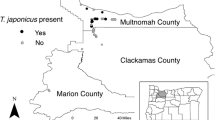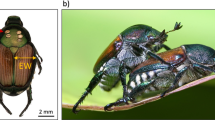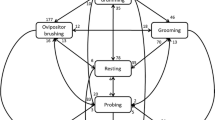Abstract
Host detection and parasitism by egg parasitoids involve host chemical recognition, spatial overlapping, and the ability to overcome physical barriers. Within the context of importation biological control, we examined the potential of Gryon gonikopalense (Hym.: Scelionidae), against the stinkbug pest, Bagrada hilaris (Hem.: Pentatomidae). Bagrada is invasive in the Americas where it negatively impacts cruciferous cropping systems. Within Pentatomidae, bagrada possesses a unique behavioral trait in that its eggs are oviposited buried. Our study aimed to evaluate the capacity of G. gonikopalense to respond to bagrada ovipositional behavior. We showed that G. gonikopalense exhibits a well-adapted foraging behavior observed by tracking and successfully parasitizing 2 mm-deep buried bagrada eggs, which was further supported by video recordings. Four conditions of egg detectability by parasitoids (free eggs, naturally buried eggs, and manually buried with disturbed or clean sand) and foraging durations were tested in Petri dishes. The parasitism rate of 100% was obtained after 72hours for both free and naturally buried eggs; a rate of 71% was obtained after 2 h with free eggs. There was no significant difference concerning the parasitoid success rate (< 40%) with manually buried eggs. Our data suggested that host egg detection was based on chemical cues since parasitism success was reduced by up to 20% when eggs were manually buried under a clean substrate or a substrate previously used for oviposition but disturbed. Gryon gonikopalense can overcome both the egg detection and physical barrier constituted by the sand to parasitize the pest despite a reduced number of progeny produced.






Similar content being viewed by others
References
Abram PK, Mills NJ, Beers EH (2020) Classical biological control of invasive stink bugs with egg parasitoids–what does success look like? Pest Manag Sci. https://doi.org/10.1002/ps.5813
Arif MA, Guarino S, Colazza S, Peri E (2020) The Role of (E)-2-octenyl Acetate as a Pheromone of Bagrada hilaris (Burmeister): Laboratory and Field Evaluation. Insects 11:109. https://doi.org/10.3390/insects11020109
Azim MN, Shafee SA (1986) The life cycle of Bagrada picta (Fabricius). Articulata 11:261–265
Baker GL, Dysart RJ, Pigott RG (1996) Parasitism of grasshopper and locust eggs (Orthoptera: Acrididae) by Scelio species (Hymenoptera: Scelionidae) in southern Australia. Aust J Zool 44:427–443. https://doi.org/10.1071/ZO9960427
Bundy CS, Grasswitz TR, Sutherland C (2012) First report of the invasive stink bug Bagrada hilaris (Burmeister)(Heteroptera: Pentatomidae) from New Mexico, with notes on its biology. Southwest Entomol 37:411–414. https://doi.org/10.3958/059.037.0317
Bundy C S, Taylor ME, McPherson JE, Steiner RL (2019) Egg Extraction Methods for Bagrada hilaris (Heteroptera: Pentatomidae) with Notes on Ovipositional Preferences. J Entomol Sci 54: 19–29 https://doi.org/10.18474/JES18-07
Colazza S, Salerno G, Wajnberg E (1999) Volatile and contact chemicals released by Nezara viridula (Heteroptera: Pentatomidae) have a kairomonal effect on the egg parasitoid Trissolcus basalis (Hymenoptera: Scelionidae). Biol Control 16:310–317
Colazza S, Aquila G, De Pasquale C, Peri E, Millar JG (2007) The egg parasitoid Trissolcus basalis uses n-nonadecane, a cuticular hydrocarbon from its stink bug host Nezara viridula, to discriminate between female and male hosts. J Chem Ecol 33:1405–1420. https://doi.org/10.1007/s10886-007-9300-7
Conti E, Salerno G, Bin F, Williams HJ, Vinson SB (2003) Chemical cues from Murgantia histrionica eliciting host location and recognition in the egg parasitoid Trissolcus brochymenae. J Chem Ecol 29:115–130. https://doi.org/10.1023/A:1021980614512
Cusumano A, Peri E, Vinson SB, Colazza S (2012) Interspecific extrinsic and intrinsic competitive interactions in egg parasitoids. Biocontrol 57:719–734. https://doi.org/10.1007/s10526-012-9451-5
Damman H, Cappuccino N (1991) Two forms of egg defence in a chrysomelid beetle: egg clumping and excrement cover. Ecol Entomol 16:163–167. https://doi.org/10.1111/j.1365-2311.1991.tb00205.x
Dangerfield P, Austin A, Baker G (2001) Biology, Ecology and Systematics of Australian Scelio: wasp parasitoids of locust and grasshopper eggs. Csiro Publishing
Darling DC, Johnson NF (1982) Egg mortality in the eastern tent caterpillar, Malacosoma americanum (Lepidoptera: Lasiocampidae): the role of accessory gland secretions and egg mass shape. Proc Entomol Soc Wash 84:448–460
Edgerly JS (1987) Maternal behaviour of a webspinner (Order Embiidina). Ecol Entomol 12:1–11. https://doi.org/10.1111/j.1365-2311.1987.tb00979.x
Fatouros NE, Dicke M, Mumm R, Meiners T, Hilker M (2008) Foraging behavior of egg parasitoids exploiting chemical information. Behav Ecol 19:677–689. https://doi.org/10.1093/beheco/arn011
Faúndez EI, Lüer A, Cuevas AG, Rider DA, Valdebenito P (2016) First record of the painted bug Bagrada hilaris (Burmeister, 1835)(Heteroptera: Pentatomidae) in South America. Arquivos Entomolóxicos 16:175–179
Felipe-Victoriano M, Talamas EJ, Sánchez-Peña SR (2019) Scelionidae (Hymenoptera) parasitizing eggs of Bagrada hilaris (Hemiptera, Pentatomidae) in Mexico. J Hymenopt Res 73:143. https://doi.org/10.3897/jhr.73.36654
Frenoy C, Durier C, Hawlitzky N (1992) Effect of kairomones from egg and female adult stages of Ostrinia nubilalis (Hübner)(Lepidoptera, Pyralidae) on Trichogramma brassicae Bezdenko (Hymenoptera, Trichogrammatidae) female kinesis. J Chem Ecol 18:761–773. https://doi.org/10.1007/BF00994613
Ganjisaffar F, Talamas EJ, Bon MC, Gonzalez L, Brown BV, Perring TM (2018) Trissolcus hyalinipennis Rajmohana & Narendran (Hymenoptera, Scelionidae), a parasitoid of Bagrada hilaris (Burmeister)(Hemiptera, Pentatomidae), emerges in North America. J Hymenopt Res 65:111. https://doi.org/10.3897/jhr.65.25620
Godfray HCJ (1994) Parasitoids: Behavioural and EvolutionaryEcology. Princeton University Press, Princeton
Goubault M, Outreman Y, Poinsot D, Cortesero AM (2005) Patch exploitation strategies of parasitic wasps under intraspecific competition. Behav Ecol 16:693–701. https://doi.org/10.1093/beheco/ari043
Greeney HF, Dyer LA, Smilanich AM (2012) Feeding by lepidopteran larvae is dangerous: A review of caterpillars’ chemical, physiological, morphological, and behavioral defenses against natural enemies. Invertebrate Surviv J 9:7–34
Gross P (1993) Insect behavioral and morphological defenses against parasitoids. Annu Rev Entomol 38:251–273. https://doi.org/10.1146/annurev.en.38.010193.001343
Guarino S, De Pasquale C, Peri E, Alonzo G, Colazza S (2008) Role of volatile and contact pheromones in the mating behaviour of Bagrada hilaris (Heteroptera: Pentatomidae). Eur J Entomol 105:613
Gunn DL (1918) The Bagrada Bug (Bagrada hilaris): Government Printing and Stationery Office
Hervé MM (2020) Package ‘RVAideMemoire’ https://cran.r-project.org/web/packages/RVAideMemoire/RVAideMemoire.pdf (Accessed 8 June 2020)
Higuchi H, Suzuki Y (1996) Host handling behavior of the egg parasitoid Telenomus triptus to the egg mass of the stink bug Piezodorus hybneri. Entomol Exp Appl 80:475–479. https://doi.org/10.1111/j.1570-7458.1996.tb00962.x
Hokkanen HMT, Sailer RI (1985) Success in classical biological control. Crit Rev Plant Sci 3:35–72. https://doi.org/10.1080/07352688509382203
Hokyo N, Kiritani K (1966) Oviposition behaviour of two egg parasites, Asolcus mitsukurii Ashmead and Telenomus nakagawai Watanabe [Hym., Proctotrupoidea, Scelionidae]. Entomophaga 11:191–201. https://doi.org/10.1007/BF02372941
Le Lann C, Outreman Y, van Alphen JJM, Krespi L, Pierre JS, Van Baaren J (2008) Do past experience and competitive ability influence foraging strategies of parasitoids under interspecific competition? Ecol Entomol 33:691–700. https://doi.org/10.1111/j.1365-2311.2008.01017.x
Lomeli-Flores JR, Rodriguez-Rodriguez SE, Rodriguez-Levya E, Gonzalez-Hernandez H, Gariepy TD, Talamas EJ (2019) Field studies and molecular forensics identify a new association: Idris elba Talamas, sp nov parasitizes the eggs of Bagrada hilaris (Burmeister). J Hymenopt Res 73:125–141. https://doi.org/10.3897/jhr.73.38025
Mahmood R, Walker AJ, Babar EB, Khalid R (2015) Egg parasitoids from Pakistan as possible classical biological control agents of the invasive pest Bagrada hilaris (Heteroptera: Pentatomidae). J Entomol Sci 50: 147–149 https://doi.org/10.18474/JES14-28.1
Martel G, Sforza RFH (2019) Catch me if you can: is bagrada bug able to escape its parasitoid? In: 6th international entomophagous insects conference, 9–13 Sept. Perugia, Italy
Martel G, Augé M, Talamas E, Roche M, Smith L, Sforza RFH (2019) First laboratory evaluation of Gryon gonikopalense (Hymenoptera: Scelionidae), as potential biological control agent of Bagrada hilaris (Hemiptera: Pentatomidae). Biol Control 135:48–56. https://doi.org/10.1016/j.biocontrol.2019.04.014
McPherson JE (2018) Invasive stink bugs and related species (Pentatomoidea): biology, higher systematics, semiochemistry, and management. CRC Press, USA
Mills N (2009) Egg parasitoids in biological control and integrated pest management. In Egg parasitoids in agroecosystems with emphasis on Trichogramma. Springer, Dordrecht 389–411 https://doi.org/10.1007/978-1-4020-9110-0_15
Orr DB (1988) Scelionid wasps as biological control agents: a review. Fla Entomol 71:506–528. https://doi.org/10.2307/3495011
Palumbo JC, Perring TM, Millar JG, Reed DA (2016) Biology, ecology, and management of an invasive stink bug, Bagrada hilaris, in North America. Annu Rev Entomol 61:453–473. https://doi.org/10.1146/annurev-ento-010715-023843
Power, NR (2020) Evaluation of the Parasitoid Ooencyrtus mirus (Hymenoptera: Encyrtidae) as a Potential Biological Control Agent of Bagrada hilaris (Heteroptera: Pentatomidae). PhD thesis, UC Riverside, CA, USA, 176p.
Rabb RL, Bradley JR (1970) Marking host eggs by Telenomus sphingis. Ann Entomol Soc Am 63:1053–1056. https://doi.org/10.1093/aesa/63.4.1053
Reed DA, Palumbo JC, Perring TM, May C (2013) Bagrada hilaris (Hemiptera: Pentatomidae), an invasive stink bug attacking cole crops in the southwestern United States. J Integr Pest Manag 4:C1–C7. https://doi.org/10.1603/IPM13007
Reed DA, Ganjisaffar F, Palumbo JC, Perring TM (2017) Effects of Temperatures on Immature Development and Survival of the Invasive Stink Bug (Hemiptera: Pentatomidae). J Eco Entomol 110:2497–2503. https://doi.org/10.1093/jee/tox289
Renou M, Nagnan P, Berthier A, Durier C (1992) Identification of compounds from the eggs of Ostrinia nubilalis and Mamestra brassicae having kairomone activity on Trichogramma brassicae. Entomol Exp Appl 63:291–303. https://doi.org/10.1111/j.1570-7458.1992.tb01586.x
Samuel KC (1949) Biological notes on two new egg-parasites of Bagrada picta Fabr (sic) Pentatomidae. Indian J Entomol 4:92–93
Sánchez-Peña SR (2014) First record in Mexico of the invasive stink bug Bagrada hilaris, on cultivated crucifers in Saltillo. Southwestern Entomologist 39:375–377. https://doi.org/10.3958/059.039.0219
Sforza RFH (2021) The diversity of biological control agents. In: Biological control: A global endeavour (P.G. Mason ed.). CSIRO Publishing, Canberra (Accepted)
Sforza RFH, Bon MC, Martel G, Augé M, Roche M, Mahmood R, Smith L (2017) Initial Evaluation of Two Native Egg Parasitoids for the Control of Bagrada hilaris, an Invasive Stink Bug in Western USA. 5th International Symposium on Biological Control of Arthropods, 11–15 Sept. 2017, Langkawi, Malaysia
Siva-Jothy MT, Moret Y, Rolff J (2005) Insect immunity: an evolutionary ecology perspective. Adv Insect Physiol 32:1–48. https://doi.org/10.1016/S0065-2806(05)32001-7
Strand MR, Obrycki JJ (1996) Host specificity of insect parasitoids predators. Bioscience 46:422–429. https://doi.org/10.2307/1312876
Strand MR, Vinson SB (1983) Host acceptance behavior of Telenomus heliothidis (Hymenoptera: Scelionidae) toward Heliothis virescens (Lepidoptera: Noctuidae). Ann Entomol Soc Am 76:781–785. https://doi.org/10.1093/aesa/76.4.781
Taylor ME, Bundy CS, McPherson JE (2014) Unusual ovipositional behavior of the stink bug Bagrada hilaris (Hemiptera: Heteroptera: Pentatomidae). Ann Entomol Soc Am 107:872–877. https://doi.org/10.1603/AN14029
Taylor ME, Bundy CS, McPherson JE (2015) Lige History and Laboratory rearing of Bagrada hilaris (Hemiptera: Heteroptera: Pentatomidae) with Descriptions of Immature Stages. Ann Entomol Soc Am 108:536–551. https://doi.org/10.1093/aesa/sav048
Vet LEM, Dicke M (1992) Ecology of infochemical use by natural enemies in a tritrophic context. Ann Rev Entomol 37:141–172
Vet LEM, Wäckers FL, Dicke M (1991) How to hunt for hiding hosts: the reliability-detectability problem in foraging parasitoids. Neth J Zool 41:202–213
Wiedemann LM, Canto-Silva CR, Romanowski HP, Redaelli LR (2003) Oviposition behaviour of Gryon gallardoi (Hym.; Scelionidae) on eggs of Spartocera dentiventris (Hem.; Coreidae). Braz J Biol 63: 133-139 https://doi.org/10.1590/S1519-69842003000100018
R Development Core Team (2016) R: a language and environment for statistical computing. Vienna
Acknowledgements
The overall study was conducted with the financial support of U.S. Department of Agriculture-Agricultural Research Service and the California Department of Food and Agriculture. The authors thank Dawn Gundersen-Rindal for a complete review of a previous version of the manuscript, and the two anonymous reviewers who greatly improved the quality of this manuscript. USDA is an equal opportunity employer and provider.
Funding
The overall study was conducted with the financial support of U.S. Department of Agriculture-Agricultural Research Service and California Department of Food and Agriculture.
Author information
Authors and Affiliations
Corresponding author
Ethics declarations
Conflict of interest
The authors declare that they have no conflict of interest.
Availability of data and material
complete.
Ethical approval
All applicable international, national, and/or institutional guidelines for the care and use of animals were followed.
Additional information
Communicated by N. Desneux.
Publisher's Note
Springer Nature remains neutral with regard to jurisdictional claims in published maps and institutional affiliations.
Supplementary Information
Supplementary file 1 (WMV 10841 kb)
Rights and permissions
About this article
Cite this article
Martel, G., Sforza, R.F.H. Catch me if you can: novel foraging behavior of an egg parasitoid, Gryon gonikopalense, against the stinkbug pest, Bagrada hilaris. J Pest Sci 94, 1161–1169 (2021). https://doi.org/10.1007/s10340-020-01325-4
Received:
Revised:
Accepted:
Published:
Issue Date:
DOI: https://doi.org/10.1007/s10340-020-01325-4




